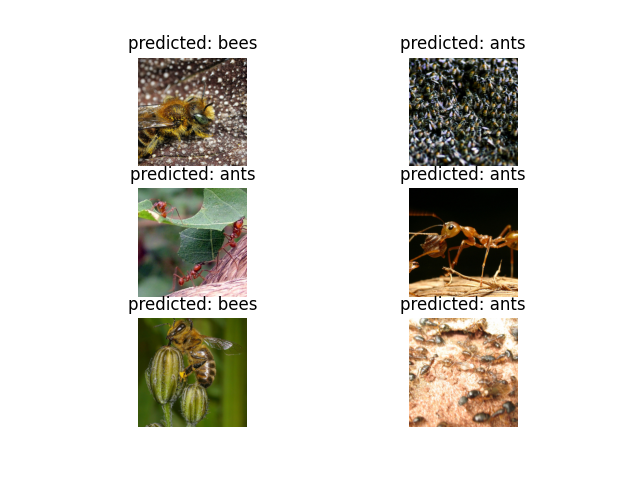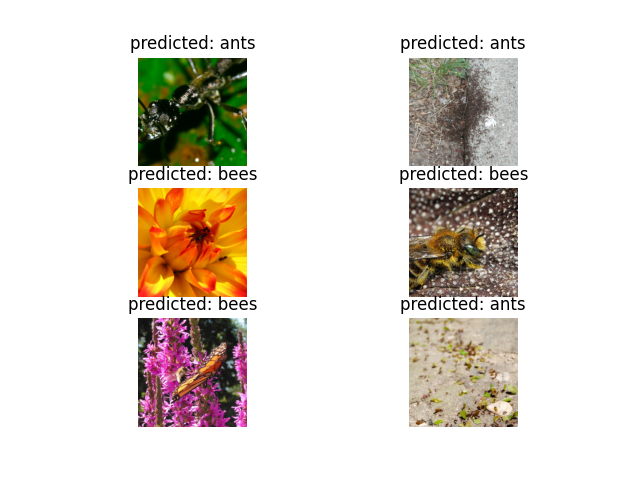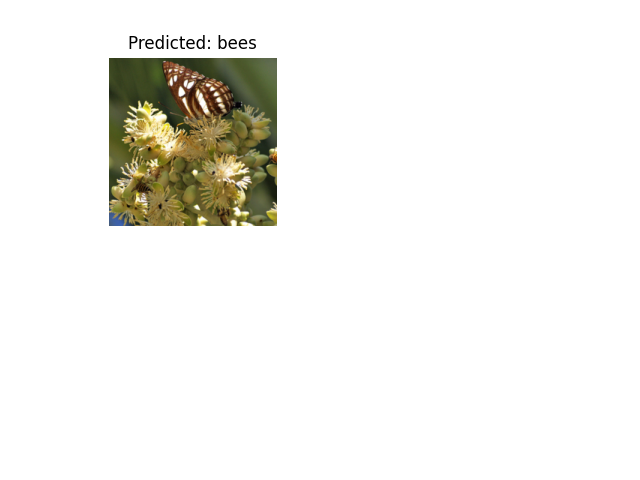


Note
Go to the end to download the full example code.
Transfer Learning for Computer Vision Tutorial#
Created On: Mar 24, 2017 | Last Updated: Jan 27, 2025 | Last Verified: Nov 05, 2024
Author: Sasank Chilamkurthy
In this tutorial, you will learn how to train a convolutional neural network for image classification using transfer learning. You can read more about the transfer learning at cs231n notes
Quoting these notes,
In practice, very few people train an entire Convolutional Network from scratch (with random initialization), because it is relatively rare to have a dataset of sufficient size. Instead, it is common to pretrain a ConvNet on a very large dataset (e.g. ImageNet, which contains 1.2 million images with 1000 categories), and then use the ConvNet either as an initialization or a fixed feature extractor for the task of interest.
These two major transfer learning scenarios look as follows:
Finetuning the ConvNet: Instead of random initialization, we initialize the network with a pretrained network, like the one that is trained on imagenet 1000 dataset. Rest of the training looks as usual.
ConvNet as fixed feature extractor: Here, we will freeze the weights for all of the network except that of the final fully connected layer. This last fully connected layer is replaced with a new one with random weights and only this layer is trained.
# License: BSD
# Author: Sasank Chilamkurthy
import torch
import torch.nn as nn
import torch.optim as optim
from torch.optim import lr_scheduler
import torch.backends.cudnn as cudnn
import numpy as np
import torchvision
from torchvision import datasets, models, transforms
import matplotlib.pyplot as plt
import time
import os
from PIL import Image
from tempfile import TemporaryDirectory
cudnn.benchmark = True
plt.ion() # interactive mode
<contextlib.ExitStack object at 0x7f59e319de70>
Load Data#
We will use torchvision and torch.utils.data packages for loading the data.
The problem we’re going to solve today is to train a model to classify ants and bees. We have about 120 training images each for ants and bees. There are 75 validation images for each class. Usually, this is a very small dataset to generalize upon, if trained from scratch. Since we are using transfer learning, we should be able to generalize reasonably well.
This dataset is a very small subset of imagenet.
Note
Download the data from here and extract it to the current directory.
# Data augmentation and normalization for training
# Just normalization for validation
data_transforms = {
'train': transforms.Compose([
transforms.RandomResizedCrop(224),
transforms.RandomHorizontalFlip(),
transforms.ToTensor(),
transforms.Normalize([0.485, 0.456, 0.406], [0.229, 0.224, 0.225])
]),
'val': transforms.Compose([
transforms.Resize(256),
transforms.CenterCrop(224),
transforms.ToTensor(),
transforms.Normalize([0.485, 0.456, 0.406], [0.229, 0.224, 0.225])
]),
}
data_dir = 'data/hymenoptera_data'
image_datasets = {x: datasets.ImageFolder(os.path.join(data_dir, x),
data_transforms[x])
for x in ['train', 'val']}
dataloaders = {x: torch.utils.data.DataLoader(image_datasets[x], batch_size=4,
shuffle=True, num_workers=4)
for x in ['train', 'val']}
dataset_sizes = {x: len(image_datasets[x]) for x in ['train', 'val']}
class_names = image_datasets['train'].classes
# We want to be able to train our model on an `accelerator <https://pytorch.org/docs/stable/torch.html#accelerators>`__
# such as CUDA, MPS, MTIA, or XPU. If the current accelerator is available, we will use it. Otherwise, we use the CPU.
device = torch.accelerator.current_accelerator().type if torch.accelerator.is_available() else "cpu"
print(f"Using {device} device")
Using cuda device
Visualize a few images#
Let’s visualize a few training images so as to understand the data augmentations.
def imshow(inp, title=None):
"""Display image for Tensor."""
inp = inp.numpy().transpose((1, 2, 0))
mean = np.array([0.485, 0.456, 0.406])
std = np.array([0.229, 0.224, 0.225])
inp = std * inp + mean
inp = np.clip(inp, 0, 1)
plt.imshow(inp)
if title is not None:
plt.title(title)
plt.pause(0.001) # pause a bit so that plots are updated
# Get a batch of training data
inputs, classes = next(iter(dataloaders['train']))
# Make a grid from batch
out = torchvision.utils.make_grid(inputs)
imshow(out, title=[class_names[x] for x in classes])
![['ants', 'bees', 'ants', 'bees']](../_images/sphx_glr_transfer_learning_tutorial_001.png)
Training the model#
Now, let’s write a general function to train a model. Here, we will illustrate:
Scheduling the learning rate
Saving the best model
In the following, parameter scheduler is an LR scheduler object from
torch.optim.lr_scheduler.
def train_model(model, criterion, optimizer, scheduler, num_epochs=25):
since = time.time()
# Create a temporary directory to save training checkpoints
with TemporaryDirectory() as tempdir:
best_model_params_path = os.path.join(tempdir, 'best_model_params.pt')
torch.save(model.state_dict(), best_model_params_path)
best_acc = 0.0
for epoch in range(num_epochs):
print(f'Epoch {epoch}/{num_epochs - 1}')
print('-' * 10)
# Each epoch has a training and validation phase
for phase in ['train', 'val']:
if phase == 'train':
model.train() # Set model to training mode
else:
model.eval() # Set model to evaluate mode
running_loss = 0.0
running_corrects = 0
# Iterate over data.
for inputs, labels in dataloaders[phase]:
inputs = inputs.to(device)
labels = labels.to(device)
# zero the parameter gradients
optimizer.zero_grad()
# forward
# track history if only in train
with torch.set_grad_enabled(phase == 'train'):
outputs = model(inputs)
_, preds = torch.max(outputs, 1)
loss = criterion(outputs, labels)
# backward + optimize only if in training phase
if phase == 'train':
loss.backward()
optimizer.step()
# statistics
running_loss += loss.item() * inputs.size(0)
running_corrects += torch.sum(preds == labels.data)
if phase == 'train':
scheduler.step()
epoch_loss = running_loss / dataset_sizes[phase]
epoch_acc = running_corrects.double() / dataset_sizes[phase]
print(f'{phase} Loss: {epoch_loss:.4f} Acc: {epoch_acc:.4f}')
# deep copy the model
if phase == 'val' and epoch_acc > best_acc:
best_acc = epoch_acc
torch.save(model.state_dict(), best_model_params_path)
print()
time_elapsed = time.time() - since
print(f'Training complete in {time_elapsed // 60:.0f}m {time_elapsed % 60:.0f}s')
print(f'Best val Acc: {best_acc:4f}')
# load best model weights
model.load_state_dict(torch.load(best_model_params_path, weights_only=True))
return model
Visualizing the model predictions#
Generic function to display predictions for a few images
def visualize_model(model, num_images=6):
was_training = model.training
model.eval()
images_so_far = 0
fig = plt.figure()
with torch.no_grad():
for i, (inputs, labels) in enumerate(dataloaders['val']):
inputs = inputs.to(device)
labels = labels.to(device)
outputs = model(inputs)
_, preds = torch.max(outputs, 1)
for j in range(inputs.size()[0]):
images_so_far += 1
ax = plt.subplot(num_images//2, 2, images_so_far)
ax.axis('off')
ax.set_title(f'predicted: {class_names[preds[j]]}')
imshow(inputs.cpu().data[j])
if images_so_far == num_images:
model.train(mode=was_training)
return
model.train(mode=was_training)
Finetuning the ConvNet#
Load a pretrained model and reset final fully connected layer.
model_ft = models.resnet18(weights='IMAGENET1K_V1')
num_ftrs = model_ft.fc.in_features
# Here the size of each output sample is set to 2.
# Alternatively, it can be generalized to ``nn.Linear(num_ftrs, len(class_names))``.
model_ft.fc = nn.Linear(num_ftrs, 2)
model_ft = model_ft.to(device)
criterion = nn.CrossEntropyLoss()
# Observe that all parameters are being optimized
optimizer_ft = optim.SGD(model_ft.parameters(), lr=0.001, momentum=0.9)
# Decay LR by a factor of 0.1 every 7 epochs
exp_lr_scheduler = lr_scheduler.StepLR(optimizer_ft, step_size=7, gamma=0.1)
Downloading: "https://download.pytorch.org/models/resnet18-f37072fd.pth" to /var/lib/ci-user/.cache/torch/hub/checkpoints/resnet18-f37072fd.pth
0%| | 0.00/44.7M [00:00<?, ?B/s]
93%|█████████▎| 41.5M/44.7M [00:00<00:00, 434MB/s]
100%|██████████| 44.7M/44.7M [00:00<00:00, 434MB/s]
Train and evaluate#
It should take around 15-25 min on CPU. On GPU though, it takes less than a minute.
model_ft = train_model(model_ft, criterion, optimizer_ft, exp_lr_scheduler,
num_epochs=25)
Epoch 0/24
----------
train Loss: 0.5191 Acc: 0.7295
val Loss: 0.1589 Acc: 0.9412
Epoch 1/24
----------
train Loss: 0.4898 Acc: 0.7787
val Loss: 0.8643 Acc: 0.7320
Epoch 2/24
----------
train Loss: 0.5114 Acc: 0.7828
val Loss: 0.2484 Acc: 0.8954
Epoch 3/24
----------
train Loss: 0.4539 Acc: 0.8279
val Loss: 0.3863 Acc: 0.8497
Epoch 4/24
----------
train Loss: 0.4517 Acc: 0.8648
val Loss: 0.2573 Acc: 0.9150
Epoch 5/24
----------
train Loss: 0.5735 Acc: 0.7459
val Loss: 0.4678 Acc: 0.8170
Epoch 6/24
----------
train Loss: 0.4120 Acc: 0.8566
val Loss: 0.3060 Acc: 0.8954
Epoch 7/24
----------
train Loss: 0.4233 Acc: 0.8320
val Loss: 0.2573 Acc: 0.9281
Epoch 8/24
----------
train Loss: 0.2284 Acc: 0.9180
val Loss: 0.2731 Acc: 0.9150
Epoch 9/24
----------
train Loss: 0.2360 Acc: 0.8893
val Loss: 0.2315 Acc: 0.9412
Epoch 10/24
----------
train Loss: 0.4634 Acc: 0.7910
val Loss: 0.2635 Acc: 0.9150
Epoch 11/24
----------
train Loss: 0.2004 Acc: 0.9057
val Loss: 0.2293 Acc: 0.9150
Epoch 12/24
----------
train Loss: 0.2442 Acc: 0.8852
val Loss: 0.2348 Acc: 0.9216
Epoch 13/24
----------
train Loss: 0.2948 Acc: 0.8689
val Loss: 0.3024 Acc: 0.9085
Epoch 14/24
----------
train Loss: 0.4004 Acc: 0.8361
val Loss: 0.2207 Acc: 0.9281
Epoch 15/24
----------
train Loss: 0.2192 Acc: 0.8975
val Loss: 0.2145 Acc: 0.9281
Epoch 16/24
----------
train Loss: 0.2806 Acc: 0.8852
val Loss: 0.2317 Acc: 0.9150
Epoch 17/24
----------
train Loss: 0.2418 Acc: 0.8975
val Loss: 0.2170 Acc: 0.9216
Epoch 18/24
----------
train Loss: 0.2784 Acc: 0.8852
val Loss: 0.1995 Acc: 0.9281
Epoch 19/24
----------
train Loss: 0.2992 Acc: 0.9016
val Loss: 0.2411 Acc: 0.9150
Epoch 20/24
----------
train Loss: 0.2567 Acc: 0.8730
val Loss: 0.2121 Acc: 0.9281
Epoch 21/24
----------
train Loss: 0.3087 Acc: 0.8525
val Loss: 0.1961 Acc: 0.9281
Epoch 22/24
----------
train Loss: 0.3088 Acc: 0.8852
val Loss: 0.2619 Acc: 0.9216
Epoch 23/24
----------
train Loss: 0.2949 Acc: 0.8730
val Loss: 0.2186 Acc: 0.9216
Epoch 24/24
----------
train Loss: 0.2265 Acc: 0.9016
val Loss: 0.2305 Acc: 0.9281
Training complete in 0m 35s
Best val Acc: 0.941176
visualize_model(model_ft)

ConvNet as fixed feature extractor#
Here, we need to freeze all the network except the final layer. We need
to set requires_grad = False to freeze the parameters so that the
gradients are not computed in backward().
You can read more about this in the documentation here.
model_conv = torchvision.models.resnet18(weights='IMAGENET1K_V1')
for param in model_conv.parameters():
param.requires_grad = False
# Parameters of newly constructed modules have requires_grad=True by default
num_ftrs = model_conv.fc.in_features
model_conv.fc = nn.Linear(num_ftrs, 2)
model_conv = model_conv.to(device)
criterion = nn.CrossEntropyLoss()
# Observe that only parameters of final layer are being optimized as
# opposed to before.
optimizer_conv = optim.SGD(model_conv.fc.parameters(), lr=0.001, momentum=0.9)
# Decay LR by a factor of 0.1 every 7 epochs
exp_lr_scheduler = lr_scheduler.StepLR(optimizer_conv, step_size=7, gamma=0.1)
Train and evaluate#
On CPU this will take about half the time compared to previous scenario. This is expected as gradients don’t need to be computed for most of the network. However, forward does need to be computed.
model_conv = train_model(model_conv, criterion, optimizer_conv,
exp_lr_scheduler, num_epochs=25)
Epoch 0/24
----------
train Loss: 0.5664 Acc: 0.7008
val Loss: 0.3242 Acc: 0.8497
Epoch 1/24
----------
train Loss: 0.4170 Acc: 0.7951
val Loss: 0.2007 Acc: 0.9477
Epoch 2/24
----------
train Loss: 0.5593 Acc: 0.7787
val Loss: 0.3106 Acc: 0.8627
Epoch 3/24
----------
train Loss: 0.5154 Acc: 0.7992
val Loss: 0.2375 Acc: 0.9085
Epoch 4/24
----------
train Loss: 0.4838 Acc: 0.7746
val Loss: 0.1862 Acc: 0.9477
Epoch 5/24
----------
train Loss: 0.4579 Acc: 0.7869
val Loss: 0.2091 Acc: 0.9477
Epoch 6/24
----------
train Loss: 0.3903 Acc: 0.8279
val Loss: 0.2157 Acc: 0.9412
Epoch 7/24
----------
train Loss: 0.3147 Acc: 0.8607
val Loss: 0.1870 Acc: 0.9412
Epoch 8/24
----------
train Loss: 0.3660 Acc: 0.8361
val Loss: 0.2477 Acc: 0.9281
Epoch 9/24
----------
train Loss: 0.3356 Acc: 0.8525
val Loss: 0.2256 Acc: 0.9281
Epoch 10/24
----------
train Loss: 0.4386 Acc: 0.8074
val Loss: 0.1925 Acc: 0.9412
Epoch 11/24
----------
train Loss: 0.3660 Acc: 0.8484
val Loss: 0.1843 Acc: 0.9477
Epoch 12/24
----------
train Loss: 0.3318 Acc: 0.8566
val Loss: 0.1871 Acc: 0.9477
Epoch 13/24
----------
train Loss: 0.3768 Acc: 0.8443
val Loss: 0.1868 Acc: 0.9412
Epoch 14/24
----------
train Loss: 0.2552 Acc: 0.8730
val Loss: 0.2534 Acc: 0.9216
Epoch 15/24
----------
train Loss: 0.2685 Acc: 0.8852
val Loss: 0.2234 Acc: 0.9412
Epoch 16/24
----------
train Loss: 0.3565 Acc: 0.8361
val Loss: 0.1885 Acc: 0.9346
Epoch 17/24
----------
train Loss: 0.3200 Acc: 0.8648
val Loss: 0.2395 Acc: 0.9412
Epoch 18/24
----------
train Loss: 0.3726 Acc: 0.8238
val Loss: 0.2357 Acc: 0.9346
Epoch 19/24
----------
train Loss: 0.3671 Acc: 0.8607
val Loss: 0.1916 Acc: 0.9542
Epoch 20/24
----------
train Loss: 0.3689 Acc: 0.8484
val Loss: 0.2182 Acc: 0.9477
Epoch 21/24
----------
train Loss: 0.4117 Acc: 0.8238
val Loss: 0.2353 Acc: 0.9346
Epoch 22/24
----------
train Loss: 0.3388 Acc: 0.8484
val Loss: 0.2034 Acc: 0.9412
Epoch 23/24
----------
train Loss: 0.3083 Acc: 0.8730
val Loss: 0.2351 Acc: 0.9346
Epoch 24/24
----------
train Loss: 0.2384 Acc: 0.8934
val Loss: 0.1882 Acc: 0.9412
Training complete in 0m 28s
Best val Acc: 0.954248
visualize_model(model_conv)
plt.ioff()
plt.show()

Inference on custom images#
Use the trained model to make predictions on custom images and visualize the predicted class labels along with the images.
def visualize_model_predictions(model,img_path):
was_training = model.training
model.eval()
img = Image.open(img_path)
img = data_transforms['val'](img)
img = img.unsqueeze(0)
img = img.to(device)
with torch.no_grad():
outputs = model(img)
_, preds = torch.max(outputs, 1)
ax = plt.subplot(2,2,1)
ax.axis('off')
ax.set_title(f'Predicted: {class_names[preds[0]]}')
imshow(img.cpu().data[0])
model.train(mode=was_training)
visualize_model_predictions(
model_conv,
img_path='data/hymenoptera_data/val/bees/72100438_73de9f17af.jpg'
)
plt.ioff()
plt.show()

Further Learning#
If you would like to learn more about the applications of transfer learning, checkout our Quantized Transfer Learning for Computer Vision Tutorial.
Total running time of the script: (1 minutes 5.053 seconds)
